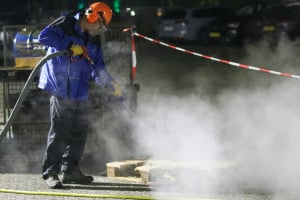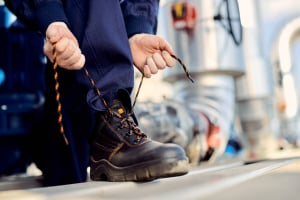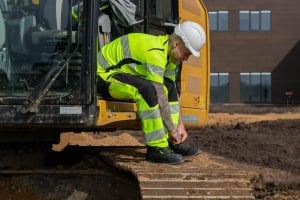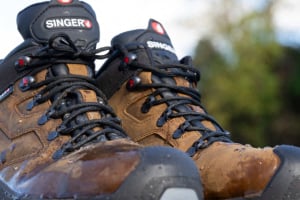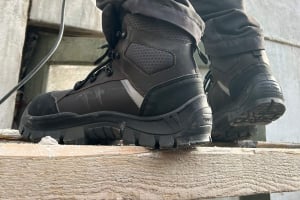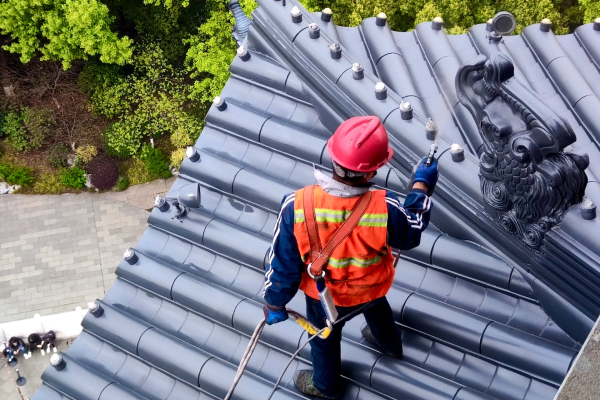
Safety at height: The essentials for working while being protected
In the construction sector as well as for all work carried out at altitude, safety at height is a very important subject. The risks associated with these activities, particularly falls, can lead to serious or even fatal consequences. At Oxwork we are deeply aware of the importance to be given to security. This article aims to highlight the essential aspects of safety at height while providing relevant advice and information. We will address the importance of safety in this area and the potential consequences of falls, while emphasizing preventive measures, necessary equipment and adequate training toguarantee a working environment combining performance and safety in height.
SUMMARY
Understanding the risks associated with working at height.
Working at height, present in sectors such as construction, industry or even logistics, carries specific risks that it is crucial to understand and manage effectively in order to be able to work safely at height.
Falls: the number 1 risk factor
Falling represents the main risk associated with working at height, the most common causes include loss of balance, inappropriate positioning of the ladder or platform, or even the incorrect use of equipment. To prevent these risks, it is essential to adopt rigorous prevention measures, raise awareness among teams and train them for working at height. Finally, it is essential, and even mandatory, to use appropriate personal protective equipment (PPE).
Injuries caused by falling objects
In addition to the risks of personal falls, there are also risks of injury due to falling objects. Tools, materials or anything falling from a height can cause serious injury to people below. To minimize this risk, it is crucial to maintain an organized workspace, securing objects using protective nets or other restraints. Finally, it is essential that the workers concerned are made aware of and trained in the management of objects during their missions at height.
No wearing of PPE
PPE is essential for the protection of workers at height. They must be used correctly, be well maintained and regularly inspected. A poorly adjusted or poorly used safety harness, for example, may not effectively restrain a worker in the event of a fall. Likewise, the use of substandard PPE can lead to serious injury in the event of an accident.
Therefore, safety at work, and more specifically when working at height, must be an absolute priority. Understanding these risks is the first step to keeping workers safe. Continuing training on the use of PPE, securing work areas and constant vigilance are essential elements to ensure safety at height.
Regulations and Standards: Legal framework and safety standards
There are many standards and regulations that govern safety at height for workers in France. Below you will find an overview of the legal provisions and essential standards.
The Labor Code stipulates specific requirements for the design of workplaces likely to present fall risks. These requirements, detailed in articlesR. 4224-5, R. 4224-7, R. 4224-8, R. 4214-2, and R. 4214-5, concern in particular walkways, floors and other risk areas.
Concerning temporary work at height, the labor code (article R.4323-58) requires that this be carried out from secure workstations , equipped with collective protection such as guardrails. Safe accessibility to workstations at height is also an obligation. When the installation of guardrails is impossible, the use of flexible collection devices or specific PPE is authorized. (Article R.4323-60 and R.4323-61)
Training and skills of workers: Work at height must be carried out by competent and trained people (articles L.4141-1 to 4141-4). Specific training is required for the use of certain equipment.
All of these regulations aim to minimize risks and ensure a safe working environment for those operating at height. They highlight the importance of a proactive approach to safety where accident prevention requires careful planning and adequate worker training.
Safety equipment: the choice and use of PPE
The use of personal protective equipment (PPE) is crucial and mandatory to ensure the safety of workers. This equipment is designed to protect them against the risk of falls and injuries. Here is an overview of essential PPE and their proper use:
Safety Harness
Harnesses are essential for safety at height, they keep the entire body secure with attachment points and fixed buckles to hold the user in the event of a fall. A harness must be properly adjusted, comfortable, and in good working order. Combined with fall arrest systems such as lifelines and lanyards, these elements provide optimal safety for dangerous environments at height.
Safety helmets
As in all construction sites and works, wearing a helmet is obligatory, this allows you to protect your head in the event of a possible impact caused, for example, by a falling object or by a collision during a fall or during a maneuver. The helmet must fit well and must meet current safety standards.
Safety shoes
Safety shoes are mandatory PPE and governed by laws, work at height is no exception to the rule, it is essential to wear them. Safety shoes provide traction to prevent slips and falls, and offer protection against punctures or possible impacts. It is essential to choose the right shoes adapted according to the defined work environment this is why at Oxwork, we offer a wide range of safety shoes meeting different standards and meeting all the needs of various professional environments.
In addition to choosing PPE, it is also very important to know how to use them properly. Indeed, adequate training is essential for workers who must know how to adjust and use each piece of equipment efficiently and safely. In addition, it is necessary to regularly inspect PPE and maintain it in good working order because the slightest wear and tear can lead to an accident if the equipment does not perform its function properly.
The importance of training and information for working at height
After having seen the mandatory equipment, the standards governing the environment and the risks of accidents in this environment, there remains one last significant part: The training and awareness of workers which are essential pillars to ensure safety in height. These two elements not only prevent accidents, but also create a culture of safety within the company.
Technical and practical training
Training must cover safe work techniques allowing workers to take as few risks as possible, the correct use of equipment as we have seen previously, and finally, the recognition of potential dangers in order to avoid any accident. For this it is always beneficial to carry out practical sessions such as simulations of real situations allowing workers to obtain practical experience and learn how to react correctly in the event of an emergency.
Risk awareness
It is very important that every worker is aware of the risks associated with working at height. This includes understanding the consequences of falls, slips and other potential accidents. In addition, it is essential that workers have knowledge of the technical and practical means of avoiding these risks.
Updating and continuing education
Regarding everything just mentioned above, training and awareness must be regularly updated on an ongoing basis. In fact, these events should in no case be one-off and “refresher” sessions are necessary to maintain and improve the skills and knowledge of workers. In addition, new technologies appear regularly and bring other elements to know, so it is essential thateveryone can adapt and know the best practices and legal requirements.
Role of the employer
The employer has a legal responsibility to provide adequate training to its employees. This includes ensuring that all workers have the skills and knowledge necessary to perform their jobs safely. Additionally, by emphasizing training and awareness, the employer helps establish a safety culture within the company where each team member isaware of the importance of safety and commits to working while protecting himself and his colleagues.
In summary, training and awareness are essential to guarantee safety when working at height. They not only provide workers with the skills necessary to work safely, but also develop a deep understanding of risks and best practices in the field.
Impact of technology on safety at height:
Technological advancement regularly brings improvement in the daily lives of millions of people. And even more so when we think of the construction professions which are sensitive to innovations strengthening their catalog of professional tools. Thus, tools are emerging to greatly improve the safety at height of workers in risky environments.
Drones and Robotics:
Drones have become more and more popular in recent years, whether in leisure (photography, video), in sport (drone racing, aerobatics) but also in the professional world. Nowadays, drones make it possible, for example, to inspect structures at height without risking worker safety. There are also robots that can carry out certain tasks at height, thus reducing human intervention as much as possible.
Advanced drop systems
Technological innovations are also taking place at the level ofequipment design, we are now seeing intelligent harnesses equipped with sensors that monitor working conditions and alert in the event of potential danger. Fall arrest systems also have their share of modifications and are becoming more and more efficient in absorbing energy during a fall and thus reducing the risk of injury.
Equipment materials and designs
The discovery of new materials makes it possible to create ever more robust and comfortable equipment allowing freedom of movement to workers. In addition, these materials can be lighter and thus reduce muscle fatigue making it possible to increase the efficiency of PPE wearers and reduce their risk of injuries due to fatigue, inattention for example.
To conclude this article, safety at height is an essential aspect which requires constant attention and a global approach. It is imperative to understand the risks, scrupulously respect standards and regulations and adopt appropriate personal protection teams. Training and awareness of workers are also fundamental pillars for maintaining a safe working environment. The integration of technological innovations represents a promising step forward to further improve security. Ultimately, safety at height is a shared responsibility, requiring everyone's commitment to ensure safe and efficient working.

